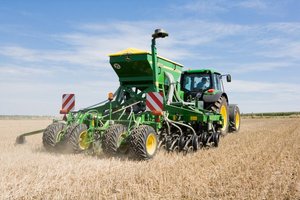The time had flown until the three minutes of added time that seemed an eternity but the Mighty U’s (Cambridge United) held on for a famous draw with Manchester United. The two and a half mile trek back home through freezing rain seemed pleasurable after such a dramatic match. This year’s FA Cup run looks like trebling the gross income of Cambridge United. I hope they invest this windfall wisely. They have made a sensible start; the chairman has just announced that they are going to build new toilets.
Farmers are used to such variation in income and as I said in last week’s blog, some Canadian and US farmers are investing the reasonable profits from the last few years into equipment to improve productivity and also, hopefully, to improve soil conditions: not that their track record over recent years has been lacking.
Currently at least 40% of the 300,000-400,000 hectares of winter wheat in Ontario is undersown in the spring with red clover. This really bursts into growth after the late July/early August harvest and is then killed by glyphosate at the end of October. This provides around 75 kg/ha of N to the following grain maize crop in addition to returning additional plant material to the soil. The latter is particularly useful because the wheat straw is baled and used by the many local dairy and pig units.
It is interesting that this practice enables such a meaningful reduction in the optimum dose of bag nitrogen to the following crop. The New Farming Systems (NFS) experiments by NIAB TAG at Morley (funded by The Morley Agricultural Foundation and the J C Mann Trust) have shown small yield increases in the spring crop following legume cover crops but no diminution in the optimum dose of bag nitrogen. There could be many reasons for this difference but one might well be that the soil in Ontario goes into deep freeze between late November and mid-March.
By the way, I am not too sure that we could successfully undersow red clover into our wheat crops. In the NFS experiments, the level of a companion crop of white clover surviving in a wheat crop that receives 200 kg/ha of bag N is disappointedly low.
 In this part of Canada, much of the new equipment is being used to integrate further cover cropping and no-till or strip-tillage. Some strip-till and no-till equipment can be used in the spring to sow a crop through a remarkably large and still growing cover crop. The farmers prefer to kill the cover crop with glyphosate after the spring crop is sown. This, they argue provides a far more ‘weather proof’ approach than spraying-off the cover crop before sowing.
In this part of Canada, much of the new equipment is being used to integrate further cover cropping and no-till or strip-tillage. Some strip-till and no-till equipment can be used in the spring to sow a crop through a remarkably large and still growing cover crop. The farmers prefer to kill the cover crop with glyphosate after the spring crop is sown. This, they argue provides a far more ‘weather proof’ approach than spraying-off the cover crop before sowing.
So the quest for further rounding the virtuous circle of integrating no-till with cover crops to improve soil health continues with almost religious fervour. However, the recent conference in Ontario that I attended was almost brought to a shuddering halt by the talk from one farmer. His father was one of the first farmers to adopt min-till and then no till in the 1980s. However, he noted that his yields in recent years have slipped to 9% below the average for the province. So he has started to plough one year in three and now his yields are 5% above the average for Ontario. Some of those in the audience were enraged and one even accused the speaker of destroying his father’s legacy. UK farmers can become rather heated about tillage and this session proved that North American farmers share the same passion for the subject.
I suppose it all comes down to whether there is a long term benefit, in terms of soil quality and productivity, from no-till and adding additional vegetable matter through cover cropping. It is obvious that many farmers think that there are benefits to the long-term adoption of no-till but I am not aware of any convincing evidence in terms of crop yields to support this notion. There is convincing evidence that not moving the soil will typically reduce erosion (although not in every case), increase the level of organic matter close to the surface and increase the number of ground beetles and earthworms but yields suggest that these advantages do not mean as much to the crop as perhaps we think they should. Neither do I argue with the huge potential cost savings from adopting no-till.
In some cases, there are real problems as a result of the continuous adoption of no-till. In such systems, there is a more rapid build of herbicide resistance. In addition, some remarkable problems have occurred in Australia where, in places, large infestations of mice, millipedes or earwigs have built up and have caused considerable crop losses. Also, in parts of Western Australia, continuous no-till has resulted in a waxy type deposit forming around surface soil aggregates, thus dramatically reducing percolation of crop limiting rainfall. Therefore, fervour has to be balanced by realism and a more rational debate.
